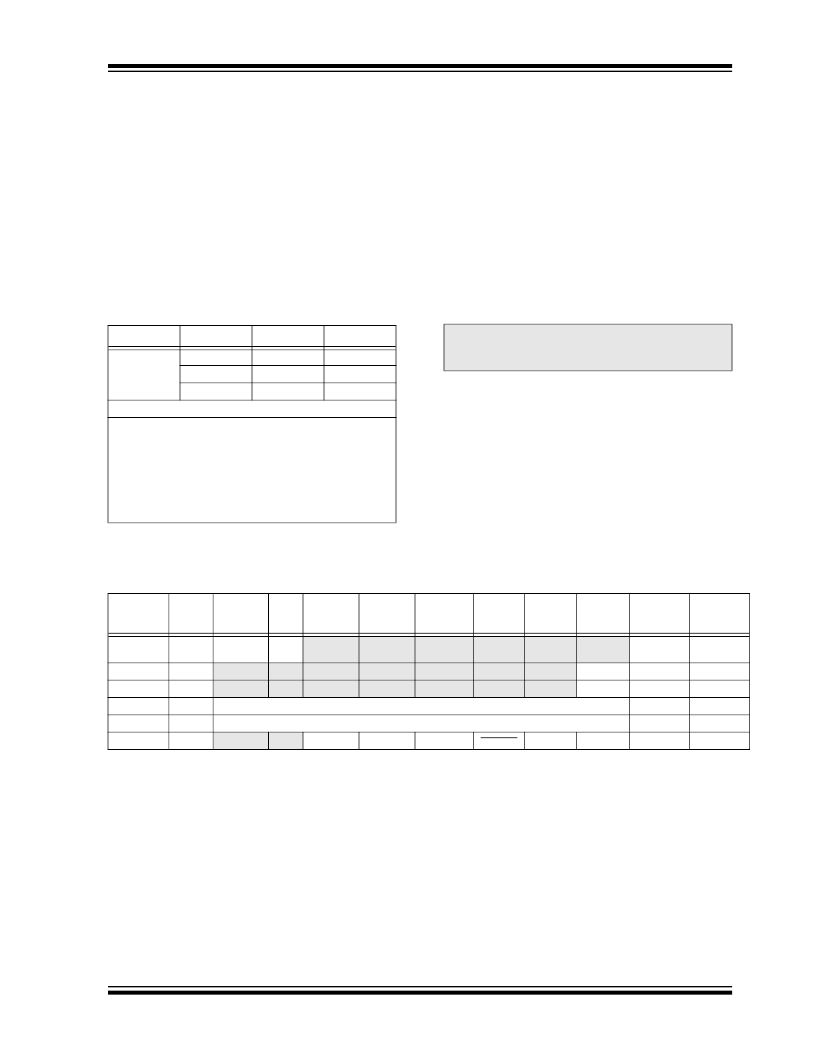- 您現(xiàn)在的位置:買賣IC網(wǎng) > PDF目錄368024 > PIC16C717 (Microchip Technology Inc.) 8-Bit CMOS Microcontrollers(8位CMOS微控制器) PDF資料下載
參數(shù)資料
| 型號: | PIC16C717 |
| 廠商: | Microchip Technology Inc. |
| 英文描述: | 8-Bit CMOS Microcontrollers(8位CMOS微控制器) |
| 中文描述: | 8位CMOS微控制器(8位的CMOS微控制器) |
| 文件頁數(shù): | 51/220頁 |
| 文件大?。?/td> | 3585K |
| 代理商: | PIC16C717 |
第1頁第2頁第3頁第4頁第5頁第6頁第7頁第8頁第9頁第10頁第11頁第12頁第13頁第14頁第15頁第16頁第17頁第18頁第19頁第20頁第21頁第22頁第23頁第24頁第25頁第26頁第27頁第28頁第29頁第30頁第31頁第32頁第33頁第34頁第35頁第36頁第37頁第38頁第39頁第40頁第41頁第42頁第43頁第44頁第45頁第46頁第47頁第48頁第49頁第50頁當前第51頁第52頁第53頁第54頁第55頁第56頁第57頁第58頁第59頁第60頁第61頁第62頁第63頁第64頁第65頁第66頁第67頁第68頁第69頁第70頁第71頁第72頁第73頁第74頁第75頁第76頁第77頁第78頁第79頁第80頁第81頁第82頁第83頁第84頁第85頁第86頁第87頁第88頁第89頁第90頁第91頁第92頁第93頁第94頁第95頁第96頁第97頁第98頁第99頁第100頁第101頁第102頁第103頁第104頁第105頁第106頁第107頁第108頁第109頁第110頁第111頁第112頁第113頁第114頁第115頁第116頁第117頁第118頁第119頁第120頁第121頁第122頁第123頁第124頁第125頁第126頁第127頁第128頁第129頁第130頁第131頁第132頁第133頁第134頁第135頁第136頁第137頁第138頁第139頁第140頁第141頁第142頁第143頁第144頁第145頁第146頁第147頁第148頁第149頁第150頁第151頁第152頁第153頁第154頁第155頁第156頁第157頁第158頁第159頁第160頁第161頁第162頁第163頁第164頁第165頁第166頁第167頁第168頁第169頁第170頁第171頁第172頁第173頁第174頁第175頁第176頁第177頁第178頁第179頁第180頁第181頁第182頁第183頁第184頁第185頁第186頁第187頁第188頁第189頁第190頁第191頁第192頁第193頁第194頁第195頁第196頁第197頁第198頁第199頁第200頁第201頁第202頁第203頁第204頁第205頁第206頁第207頁第208頁第209頁第210頁第211頁第212頁第213頁第214頁第215頁第216頁第217頁第218頁第219頁第220頁

2002 Microchip Technology Inc.
DS41120B-page 49
PIC16C717/770/771
6.2
Timer1 Oscillator
A crystal oscillator circuit is built in between pins T1OSI
(input) and T1OSO (amplifier output). It is enabled by
setting control bit T1OSCEN (T1CON<3>). The oscilla-
tor is a low power oscillator rated up to 200 kHz. It will
continue to run during SLEEP. It is primarily intended
for a 32 kHz crystal. Table 6-1 shows the capacitor
selection for the Timer1 oscillator.
The Timer1 oscillator is identical to the LP oscillator.
The user must provide a software time delay to ensure
proper oscillator start-up.
TABLE 6-1:
CAPACITOR SELECTION FOR
THE TIMER1 OSCILLATOR
6.3
Timer1 Interrupt
The TMR1 Register pair (TMR1H:TMR1L) increments
from 0000h to FFFFh and rolls over to 0000h. The
TMR1 Interrupt, if enabled, is generated on overflow
which is latched in interrupt flag bit TMR1IF (PIR1<0>).
This interrupt can be enabled/disabled by setting/clear-
ing TMR1 interrupt enable bit TMR1IE (PIE1<0>).
6.4
Resetting Timer1 using a CCP
Trigger Output
If the ECCP module is configured in Compare mode to
generate a
“
special event trigger" (CCP1M<3:0> =
1011
), this signal will reset Timer1 and start an A/D
conversion (if the A/D module is enabled).
Timer1 must be configured for either timer or Synchro-
nized Counter mode to take advantage of this feature.
If Timer1 is running in Asynchronous Counter mode,
this RESET operation may not work.
In the event that a write to Timer1 coincides with a spe-
cial event trigger from ECCP, the write will take prece-
dence.
In this mode of operation, the CCPR1H:CCPR1L regis-
ters pair effectively becomes the period register for
Timer1.
TABLE 6-2:
REGISTERS ASSOCIATED WITH TIMER1 AS A TIMER/COUNTER
Osc Type
LP
Freq
32 kHz
100 kHz
200 kHz
C1
C2
33 pF
15 pF
15 pF
33 pF
15 pF
15 pF
These values are for design guidance only.
Note 1:
Higher capacitance increases the stability
of oscillator but also increases the start-up
time.
2:
Since each resonator/crystal has its own
characteristics, the user should consult the
resonator/crystal manufacturer for appro-
priate values of external components.
Note:
The special event triggers from the CCP1
module will not set interrupt flag bit
TMR1IF (PIR1<0>).
Address
Name
Bit 7
Bit 6
Bit 5
Bit 4
Bit 3
Bit 2
Bit 1
Bit 0
Value on:
POR,
BOR
Value on
all other
RESETS
0Bh,8Bh,
10Bh,18Bh
INTCON
GIE
PEIE
T0IE
INTE
RBIE
T0IF
INTF
RBIF
0000 000x
0000 000u
0Ch
PIR1
—
ADIF
—
—
SSPIF
CCP1IF
TMR2IF
TMR1IF
-0-- 0000
-0-- 0000
8Ch
PIE1
—
ADIE
—
—
SSPIE
CCP1IE
TMR2IE
TMR1IE
-0-- 0000
-0-- 0000
0Eh
TMR1L
Holding register for the Least Significant Byte of the 16-bit TMR1 register
xxxx xxxx
uuuu uuuu
0Fh
TMR1H
Holding register for the Most Significant Byte of the 16-bit TMR1 register
xxxx xxxx
uuuu uuuu
10h
T1CON
—
—
T1CKPS1
T1CKPS0
T1OSCEN
T1SYNC
TMR1CS
TMR1ON
--00 0000
--uu uuuu
Legend:
x = unknown, u = unchanged, - = unimplemented read as
’
0
’
. Shaded cells are not used by the Timer1 module.
相關(guān)PDF資料 |
PDF描述 |
|---|---|
| PIC16C770 | 8-Bit CMOS Microcontrollers(8位CMOS微控制器) |
| PIC16C771 | 8-Bit CMOS Microcontrollers(8位CMOS微控制器) |
| PIC16C73A | 8-Bit CMOS Microcontrollers with A/D Converter |
| PIC16C76 | 8-Bit CMOS Microcontrollers with A/D Converter(每個I/O口有25mA驅(qū)動/吸收電流,并行從動口,2路捕捉/比較/PWM的微控制器) |
| PIC16C77 | 8-Bit CMOS Microcontrollers with A/D Converter(每個I/O口有25mA驅(qū)動/吸收電流,并行從動口,1路捕捉/比較/PWM的微控制器) |
相關(guān)代理商/技術(shù)參數(shù) |
參數(shù)描述 |
|---|---|
| PIC16C717/JW | 功能描述:8位微控制器 -MCU 3.5KB 256 RAM 16 I/O RoHS:否 制造商:Silicon Labs 核心:8051 處理器系列:C8051F39x 數(shù)據(jù)總線寬度:8 bit 最大時鐘頻率:50 MHz 程序存儲器大小:16 KB 數(shù)據(jù) RAM 大小:1 KB 片上 ADC:Yes 工作電源電壓:1.8 V to 3.6 V 工作溫度范圍:- 40 C to + 105 C 封裝 / 箱體:QFN-20 安裝風(fēng)格:SMD/SMT |
| PIC16C717/P | 功能描述:8位微控制器 -MCU 3.5KB 256 RAM 16 I/O RoHS:否 制造商:Silicon Labs 核心:8051 處理器系列:C8051F39x 數(shù)據(jù)總線寬度:8 bit 最大時鐘頻率:50 MHz 程序存儲器大小:16 KB 數(shù)據(jù) RAM 大小:1 KB 片上 ADC:Yes 工作電源電壓:1.8 V to 3.6 V 工作溫度范圍:- 40 C to + 105 C 封裝 / 箱體:QFN-20 安裝風(fēng)格:SMD/SMT |
| PIC16C717/P | 制造商:Microchip Technology Inc 功能描述:IC 8BIT CMOS MCU 16C717 DIP18 |
| PIC16C717/P | 制造商:Microchip Technology Inc 功能描述:Microcontroller IC Number of I/Os:16 |
| PIC16C717/PC01 | 制造商:Microchip Technology Inc 功能描述: |
發(fā)布緊急采購,3分鐘左右您將得到回復(fù)。